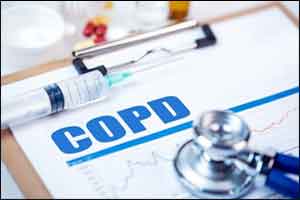- Home
- Editorial
- News
- Practice Guidelines
- Anesthesiology Guidelines
- Cancer Guidelines
- Cardiac Sciences Guidelines
- Critical Care Guidelines
- Dentistry Guidelines
- Dermatology Guidelines
- Diabetes and Endo Guidelines
- Diagnostics Guidelines
- ENT Guidelines
- Featured Practice Guidelines
- Gastroenterology Guidelines
- Geriatrics Guidelines
- Medicine Guidelines
- Nephrology Guidelines
- Neurosciences Guidelines
- Obs and Gynae Guidelines
- Ophthalmology Guidelines
- Orthopaedics Guidelines
- Paediatrics Guidelines
- Psychiatry Guidelines
- Pulmonology Guidelines
- Radiology Guidelines
- Surgery Guidelines
- Urology Guidelines
COPD: LABA/LAMA dual bronchodilation improves Cardiac function

Dual bronchodilation with LABA/LAMA Combo of indacaterol-glycopyrronium is associated with significant improvement of cardiac function in patients with chronic obstructive pulmonary disease (COPD) and lung hyperinflation, according to a new study.
Chronic obstructive pulmonary disease (COPD) is a chronic inflammatory lung disease that causes obstructed airflow from the lungs pulmonary hyperinflation in chronic obstructive pulmonary disease (COPD) is associated with reduced biventricular end-diastolic volumes and increased morbidity and mortality.
Jens M Hohlfeld et. al conducted a study to analyze the effect of LABA–LAMA combination therapy on cardiac function in patients with COPD and lung hyperinflation.
The study was a double-blind, randomized, two-period crossover, placebo-controlled, single-center (CLAIM) which included patients aged at least 40 years with COPD, pulmonary hyperinflation, a smoking history of at least ten pack-years, and airflow limitation.
Out of 62 eligible participants, 30 were assigned to indacaterol–glycopyrronium followed by placebo and 32 to placebo followed by indacaterol–glycopyrronium. The 62 randomly assigned patients were included in the intent-to-treat analysis. There were two protocol violations and therefore 60 were included in the per-protocol analysis
A total of 57 patients completed both periods of treatment. Findings indicated that left-ventricular end-diastolic volume increased from a mean 55.46 mL/m2 at baseline to a least-squares mean of 61.76 mL/m2 following treatment with indacaterol-glycopyrronium, compared with a change from 56.42 mL/m2 at baseline to 56.53 mL/m2 following treatment with placebo.
Commonly reported adverse events with indacaterol-glycopyrronium treatment were a cough and throat irritation as compared to a headache and upper respiratory tract infection with placebo. No patient deaths occurred during the study.
The study concluded that dual bronchodilation with indacaterol–glycopyrronium significantly improved cardiac function as measured by left-ventricular end-diastolic volume and will support the early use of dual bronchodilation in patients with COPD who show signs of pulmonary hyperinflation.
The study was published in the journal Lancet Respiratory Medicine.
For more reference log on to: https://doi.org/10.1016/S2213-2600(18)30054-7

Disclaimer: This site is primarily intended for healthcare professionals. Any content/information on this website does not replace the advice of medical and/or health professionals and should not be construed as medical/diagnostic advice/endorsement or prescription. Use of this site is subject to our terms of use, privacy policy, advertisement policy. © 2020 Minerva Medical Treatment Pvt Ltd